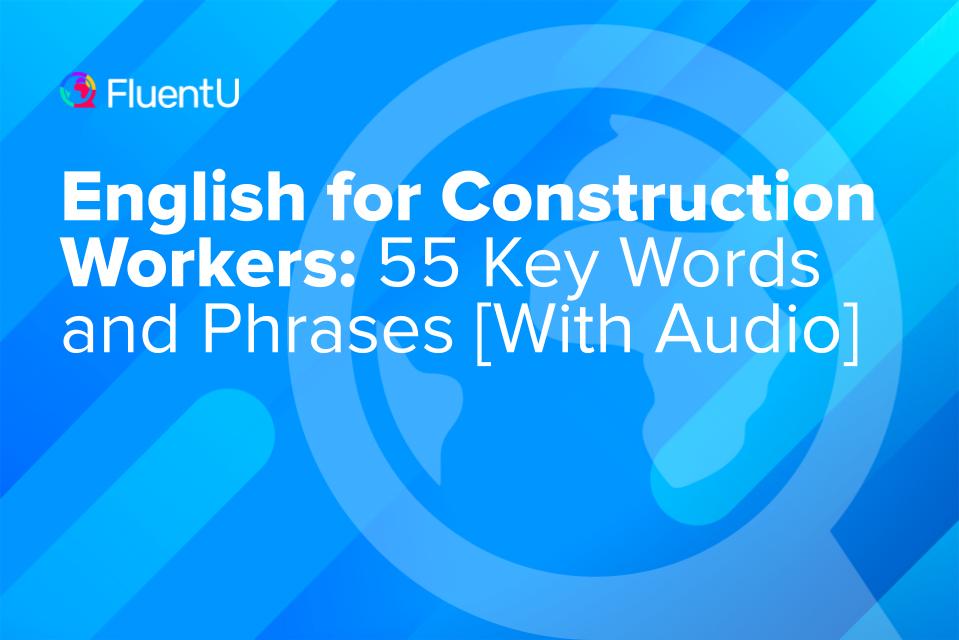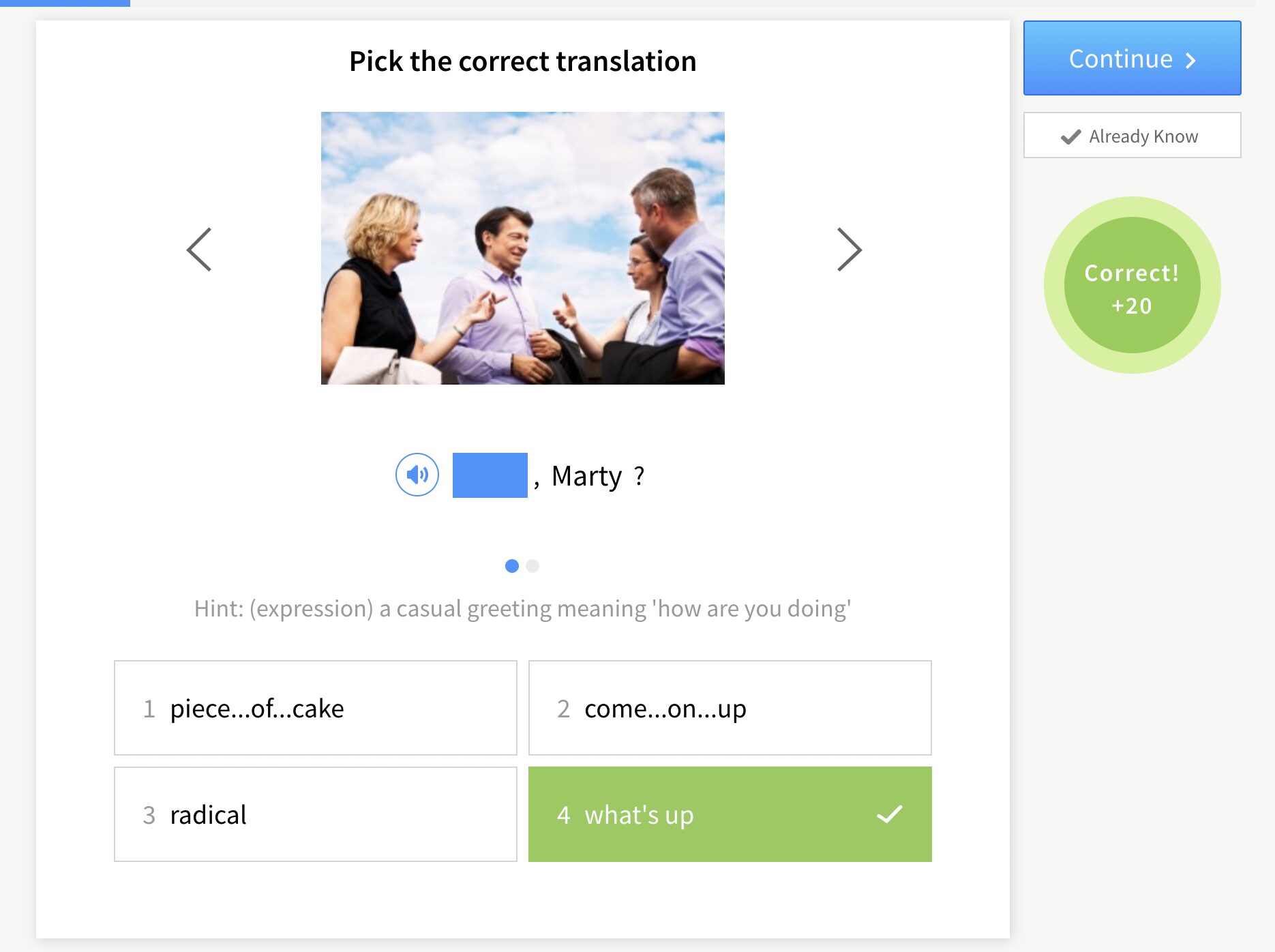English for Construction Workers: 55 Key Words and Phrases [With Audio]

In the fast-paced world of construction, effective communication is key to ensuring that projects get completed safely and efficiently. And if you’re an English learner working in the construction industry, you’re going to need to know the lingo.
In this article, you’ll learn 55 important words and phrases used on construction sites. From reading blueprints to talking to your co-workers and bosses or clients, we’ve got you covered.
Download: This blog post is available as a convenient and portable PDF that you can take anywhere. Click here to get a copy. (Download)
Building, Updating, Destroying
Build
To construct or create something from nothing.
He’s planning to build a new house.
Reconstruct
To build again, often after a structure has been damaged.
Next week we’ll begin to reconstruct the old church.
Remodel
To change the inner structure of a building (or part of a building) in order to change its appearance.
They want to remodel the master bedroom to create more closet space.
Renovate
Similar but slightly different from “remodel.” This term refers to updating or repairing a building (or part of a building) so that it looks new again.
The kitchen is 20 years old and they want to renovate it.
Demolition
The act of destroying something or taking it down.
The demolition of the empty warehouse downtown is scheduled for next week.
Excavation
This is the process of digging and removing soil or rock from the ground to create a hole or trench. It is often done to prepare the ground for construction projects, such as building foundations or underground utilities.
The construction crew started the excavation to prepare the site for the new building’s foundation.
Sites and Spaces
Property
You probably know the general English term “property,” referring to someone’s belongings. In construction, a property is a specific piece of land—often including the building or buildings on that land.
He owns several properties in the downtown area.
Commercial property
A commercial property is a property that’s intended for non-residential buildings. In other words, it should be used for a business, not for living.
The contract is for a commercial property and the building will be for offices.
Construction site / Building site
The place where a structure is being built.
We’ll need to bring the equipment to 5th Street. That’s where the construction site is located.
Scaffolding
This is a temporary structure next to a building that workers can stand on to work on a building. It’s usually made out of wood planks and metal poles.
He fell from the scaffolding onto the sidewalk but didn’t have any serious injuries.
Hazardous
This word describes something that’s dangerous.
The weather conditions are too hazardous for work on the construction site today.
Describing Buildings and Building Materials
Blueprint
The design or drawing that shows the plan for a building or other structure, such as a house.
We got the blueprints today and everything looks perfect. When can we start to build?
Brick
A hard block, usually made out of clay, that’s used to build structures.
What are the walls made out of? We used brick.
Concrete
This is the hard, grey material used to create floors and walls, among other things. It’s poured out in liquid form and then hardens.
We’ll pour the concrete foundation today.
Rebar
Rebar (short for “reinforcing bar”) is a strong steel bar or mesh used in concrete to make it stronger and prevent cracks in buildings and structures.
Steel
This is a strong and durable metal used in constructing high-rise buildings, bridges and other structures where strength is essential.
Drywall
This is a board usually made from plaster that’s used to create the interior walls of a structure.
He ordered the drywall last month, but it hasn’t arrived yet, so we’re behind schedule.
Insulation
In construction, insulation refers to a material used to prevent heat, sound or electricity from escaping or entering a building. It helps maintain a comfortable indoor temperature and reduces energy consumption.
Beam
A piece of wood, steel or other material that runs across the structure of a building to hold weight.
We discovered cracks in this beam, which we need to address as soon as possible.
Joist
A supportive beam of wood or metal in a building. Usually, it runs parallel to the ceiling or floor. While beams are the main load-bearing structural elements of a roof and transfer the building’s weight to vertical supports, joists are smaller supports that distribute the load to the beams or walls.
We’ll finish putting in the joists today and start laying the floor tomorrow.
Vertical
The up-to-down or top-to-bottom direction.
How many vertical beams are there on each floor of the building?
Horizontal
The left-to-right or side-to-side direction.
The floor and ceiling are both horizontal.
Construction Tools
Hammer
This tool is used for hitting nails and other objects into surfaces.
He used a hammer to drive the nails into the wooden plank.
Screwdriver
This is a tool used for turning screws and bolts (metal fasteners) to fasten things together.
Tape Measure
A long, flexible ruler used to measure the length or size of objects.
Please measure the width of the door with the tape measure.
Level
This is a tool used to check if something is straight and even, like a wall or shelf.
We need a level to make sure the picture frame is straight.
Pliers
Handheld tools with two arms and a pivot used for gripping and bending wires or small objects.
You can use the pliers to twist the wires together.
Wrench
A tool used to tighten or loosen nuts and bolts.
She had to borrow a wrench from her neighbor to loosen the nuts on her bicycle tire.
Power Drill
A tool that drills holes or drives screws into materials using electricity.
With a power drill we can quickly make holes in the wall to hang the shelves.
Saw
A tool with a sharp blade used for cutting wood or other materials. There are various types of saws such as circular saws and hand saws.
Peter used a saw to cut the tree into small pieces of wood for the fireplace.
Utility Knife
A small knife with a retractable blade used for cutting various materials.
Lisa used a utility knife to open the package.
Ladder
A ladder has steps or bars to allow people to climb up and down.
I use a ladder to reach the light to change the lightbulb.
Wheelbarrow
A device used to move material such as rocks or soil from one place to another. It has one wheel on the front, so people can easily push it around.
She put the rocks from the garden into the wheelbarrow and took them to the other side of her house.
Shovel
This is a tool used to pick up dirt, sand, gravel and snow.
Give me the shovel so I can clear off the sidewalk.
Hard hat
The protective hat construction workers wear on a construction site.
You must wear a hard hat to protect your head while on the construction site.
Construction Vehicles
Bulldozer
A machine with a large shovel attached that helps to dig holes and remove rocks from the ground.
We’ll need the bulldozer to dig the foundation.
Dump truck
This is a large truck that has an open back, which can be filled with trash and debris.
The dump truck is full and needs to be emptied.
Excavator
This is a heavy machine with a bucket on the front for digging and moving earth and debris.
Crane
The tall machine that helps to lift heavy objects and materials to the upper floors of a building.
Adam is operating the crane today.
Concrete Mixer Truck
This is a vehicle with a rotating drum, used to transport and mix concrete on-site.
Grader
A machine with a long blade used for leveling and smoothing surfaces, especially roads.
The grader leveled the surface of the road, making it smooth and ready for the final asphalt layer.
Paver
A machine used for laying asphalt or concrete on roads and other surfaces.
Construction Job Titles and Positions
Architect
The person who creates or draws the design for the building, house or structure.
Rachel was the lead architect for the museum downtown.
Surveyor
A person who investigates land to see if it’s possible to build there.
The surveyor just sent us his report and we’re all set to start building.
Contractor
A contractor is a person or company that provides services for a specific job.
For the indoor pool, we’ll need to hire a contractor who has experience with this type of project.
General contractor
The person or company responsible for the everyday work of all members on a construction site.
A good general contractor anticipates problems on job sites before they happen.
Subcontractor
A person or company that does work for a contractor or larger project.
Let’s get a subcontractor for the plumbing.
Workman
A person who does manual labor and often reports to a contractor or other manager at a construction site.
How many workmen do you have on site?
Bricklayer
A person who builds walls, structures and pathways with bricks.
The bricklayers finished today and the walls look great!
Electrician
A person who installs the electric wires of a building or structure.
Plumber
A person who installs the pipes and plumbing fixtures in a building or structure.
If you don’t know how to fix your plumbing, call your local plumber.
Roofer
This person is responsible for building the roof of a building or structure.
The roofers won’t come today because it’s raining.
Steeplejack
A person who climbs tall structures and buildings to clean them and make repairs.
We need a steeplejack to get up there and fix the chimney.
Stonemason
A person who builds and works with stone.
Do we really need a stonemason? I thought we’d decided to use brick and concrete.
Carpenter
A person who builds and repairs buildings, structures and other items out of wood.
Let’s ask the carpenter to build bookshelves into this wall.
Resources for Learning English for Construction
There are many great resources available that can help you feel more confident the next time you have to speak English on a construction site. If you want to do some self-studying, check out these books:
- “Oxford Picture Dictionary”: This is a great reference book that offers an entire section on vocabulary for construction workers, with pictures to illustrate each word.
- “English for Construction 1” and “English for Construction 2”: This series is specifically designed for ESL students in the construction industry. Each book comes with a CD for listening and pronunciation practice.
You can also use a language learning program like FluentU.
FluentU takes authentic videos—like music videos, movie trailers, news and inspiring talks—and turns them into personalized language learning lessons.
You can try FluentU for free for 2 weeks. Check out the website or download the iOS app or Android app.
P.S. Click here to take advantage of our current sale! (Expires at the end of this month.)

If you’re looking for a traditional learning environment, you might benefit from a course like “Language for Professionals.” This training course for construction workers covers everything from basic tool and material terms to safety vocabulary.
Take some time to review these words, and see if you can memorize a few every day.
You’ll sound more professional and informed in no time and will be ready for your next construction site!
Download: This blog post is available as a convenient and portable PDF that you can take anywhere. Click here to get a copy. (Download)
And One More Thing…
If you’re like me and prefer learning English on your own time, from the comfort of your smart device, I’ve got something you’ll love.
With FluentU’s Chrome Extension, you can turn any YouTube or Netflix video with subtitles into an interactive language lesson. That means you can learn from real-world content, just as native English speakers actually speak.
You can even import your favorite YouTube videos into your FluentU account. If you’re not sure where to start, check out our curated library of videos that are handpicked for beginners and intermediate learners, as you can see here:
FluentU brings native English videos within reach. With interactive captions, you can hover over any word to see an image, definition, and pronunciation.
Just click on the word to see other example sentences and videos where the word is used in different contexts. Plus, you can add it to your flashcards! For example, if I tap on the word "viral," this is what pops up:
Want to make sure you really remember what you've learned? We’ve got you covered. Practice and reinforce the vocab from each video with learn mode. Swipe to see more examples of the word you’re learning, and play mini-games with our dynamic flashcards.
The best part? FluentU tracks everything you’re learning and uses that to create a personalized experience just for you. You’ll get extra practice with tricky words and even be reminded when it’s time to review—so nothing slips through the cracks.
Start using the FluentU website on your computer or tablet or, better yet, download our from the App Store or Google Play.
Click here to take advantage of our current sale! (Expires at the end of this month.)












